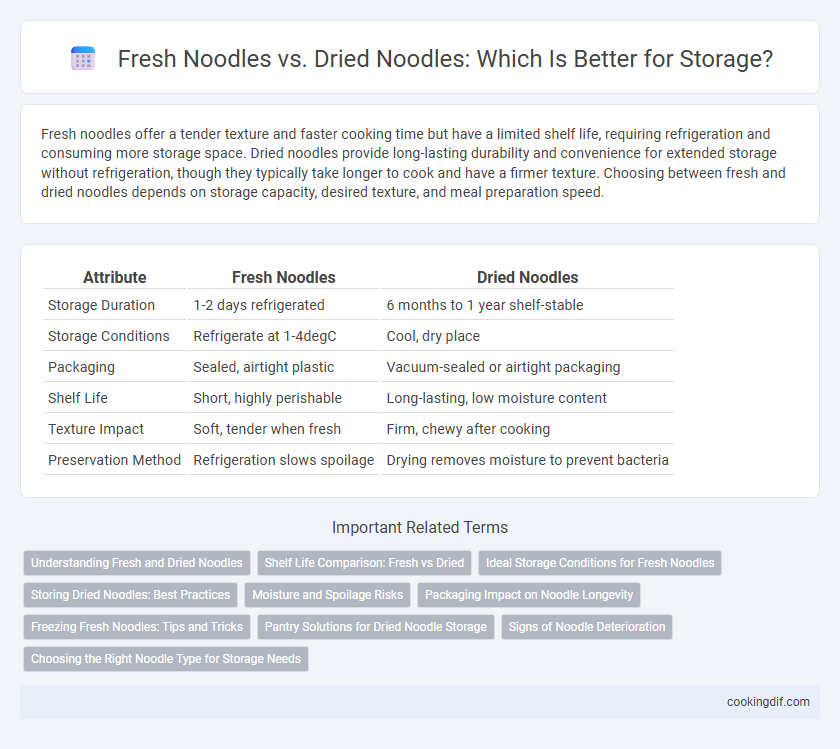Fresh noodles offer a tender texture and faster cooking time but have a limited shelf life, requiring refrigeration and consuming more storage space. Dried noodles provide long-lasting durability and convenience for extended storage without refrigeration, though they typically take longer to cook and have a firmer texture. Choosing between fresh and dried noodles depends on storage capacity, desired texture, and meal preparation speed.
Table of Comparison
| Attribute | Fresh Noodles | Dried Noodles |
|---|---|---|
| Storage Duration | 1-2 days refrigerated | 6 months to 1 year shelf-stable |
| Storage Conditions | Refrigerate at 1-4degC | Cool, dry place |
| Packaging | Sealed, airtight plastic | Vacuum-sealed or airtight packaging |
| Shelf Life | Short, highly perishable | Long-lasting, low moisture content |
| Texture Impact | Soft, tender when fresh | Firm, chewy after cooking |
| Preservation Method | Refrigeration slows spoilage | Drying removes moisture to prevent bacteria |
Understanding Fresh and Dried Noodles
Fresh noodles contain higher moisture content, making them more perishable and requiring refrigeration for short-term storage, typically lasting only a few days. Dried noodles undergo a dehydration process that significantly reduces moisture, extending shelf life to several months or even years when stored in a cool, dry environment. Understanding the differences in moisture levels and storage requirements is crucial for selecting the right type based on usage frequency and storage capabilities.
Shelf Life Comparison: Fresh vs Dried
Fresh noodles typically have a shelf life of only 2 to 5 days when refrigerated due to their high moisture content, making them prone to spoilage and bacterial growth. In contrast, dried noodles boast a significantly longer shelf life, often lasting 1 to 2 years when stored in a cool, dry environment, as the low moisture level inhibits microbial activity. This stark difference in storage longevity makes dried noodles ideal for long-term pantry storage, while fresh noodles are better suited for immediate consumption.
Ideal Storage Conditions for Fresh Noodles
Fresh noodles require refrigeration at temperatures between 32degF and 39degF (0degC to 4degC) to maintain optimal freshness and prevent spoilage, with a typical shelf life of 2 to 3 days. They should be stored in an airtight container or tightly wrapped to minimize moisture loss and microbial contamination. Unlike dried noodles, fresh noodles are highly perishable and not suitable for long-term storage without freezing, which can extend their usability up to several weeks while preserving texture and flavor.
Storing Dried Noodles: Best Practices
Storing dried noodles properly extends their shelf life up to two years by keeping them in a cool, dry place away from moisture and direct sunlight. Use airtight containers or resealable bags to prevent exposure to humidity and pests, which can degrade quality and flavor. Optimal storage conditions include temperatures below 75degF and low humidity, preserving the noodles' texture and taste for longer periods.
Moisture and Spoilage Risks
Fresh noodles contain high moisture levels, making them more prone to spoilage and microbial growth, requiring refrigeration or freezing for safe storage. Dried noodles have minimal moisture, significantly reducing the risk of spoilage and allowing for long-term storage in a cool, dry place. Proper storage conditions for each type are critical to maintaining quality and preventing contamination or mold development.
Packaging Impact on Noodle Longevity
Fresh noodles typically require airtight packaging with moisture barriers to maintain their texture and prevent spoilage, significantly limiting their shelf life compared to dried noodles. Dried noodles benefit from vacuum-sealed or nitrogen-flushed packaging that extends longevity by reducing oxidation and moisture exposure, preserving flavor and quality. Proper packaging technology directly influences noodle preservation, with dried varieties offering superior storage stability for extended periods.
Freezing Fresh Noodles: Tips and Tricks
Freezing fresh noodles preserves their texture and flavor better than drying, maintaining a chewy consistency after cooking. To avoid clumping, toss noodles with a light coating of oil and freeze in single portions using airtight containers or freezer bags. For best results, cook frozen noodles directly from the freezer without thawing, reducing preparation time and preserving quality.
Pantry Solutions for Dried Noodle Storage
Dried noodles offer superior pantry storage solutions compared to fresh noodles due to their low moisture content, significantly extending shelf life to several months or even years when stored properly. Optimal storage conditions for dried noodles include airtight containers kept in a cool, dry place away from direct sunlight to prevent moisture absorption and infestation. Unlike fresh noodles that require refrigeration or freezing, dried noodles provide convenience and durability, making them ideal for long-term pantry stocking.
Signs of Noodle Deterioration
Fresh noodles exhibit signs of deterioration through changes such as a sticky texture, discoloration, and an off odor, while dried noodles show signs like brittleness, discoloration, and mold growth. Moisture content plays a crucial role; fresh noodles spoil faster due to higher moisture, leading to bacterial growth, whereas dried noodles have extended shelf life but can become stale or rancid over time. Proper storage conditions, such as refrigeration for fresh noodles and airtight containers for dried noodles, slow down deterioration and maintain quality.
Choosing the Right Noodle Type for Storage Needs
Fresh noodles, with their higher moisture content, require refrigeration and typically last only a few days, making them ideal for short-term use. Dried noodles, on the other hand, have a significantly extended shelf life, often lasting up to two years when stored in a cool, dry place, making them perfect for long-term storage. Selecting the right noodle type depends on balancing immediate cooking convenience with storage duration and shelf stability.
fresh noodles vs dried noodles for storage Infographic

 cookingdif.com
cookingdif.com